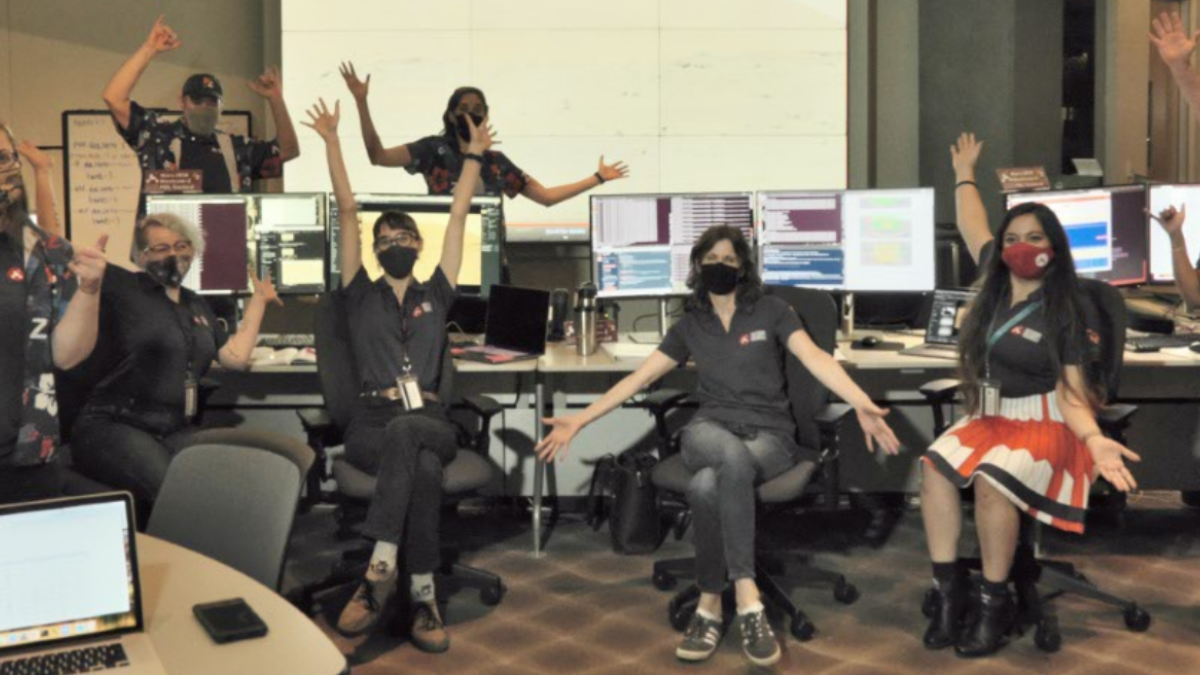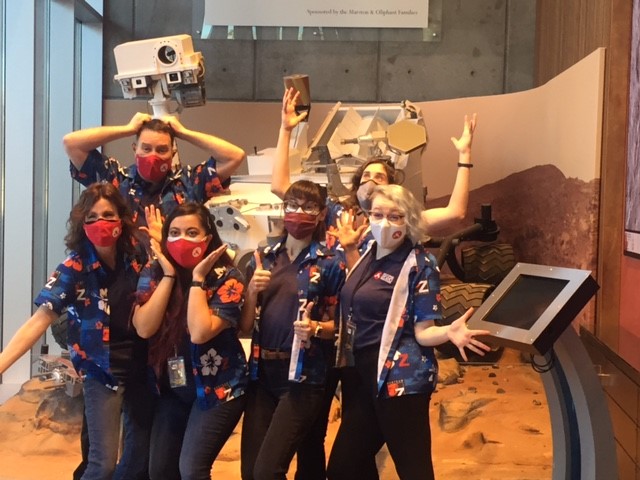NASA’s Mars 2020 Perseverance rover landed on Mars on Feb. 18, 2021. It is the most sophisticated rover NASA has ever sent to the red planet. Its science mission is to collect carefully selected and documented rock and sediment samples for future return to Earth, search for signs of ancient microbial life, characterize the planet’s geology and climate, and pave the way for human exploration beyond the moon.
Onboard the rover is the ASU-led mast-mounted camera system Mastcam-Z, which can zoom from wide angle to telephoto, take 3D images and videos, and take photos in up to 11 unique colors. The camera system is led by Jim Bell, professor and planetary scientist at ASU’s School of Earth and Space Exploration.
To produce the images and videos from Mastcam-Z and bring them back to Earth, Bell has assembled an incredible team of talented scientists at ASU, including Kristen Paris, Alyssa Bailey, Kelsie Crawford, Laura Mehall, Kathryn Powell, Corrine Rojas and contributing graduate students Samantha Jacob and Mohini Jodhpurkar.
In honor of the United Nations’ International Day of Women and Girls in Science and the first anniversary of the rover’s landing, the School of Earth and Space Exploration is highlighting the members of this incredible team, each of whom are role models not only to women and girls in science, but to STEM and space exploration enthusiasts from all walks of life.
This team works primarily on the ASU Tempe campus in a glass-walled room called Mars Mission Operations in the Interdisciplinary Science and Technology Building IV. The room is equipped with large monitors showcasing the latest images from Mastcam-Z and the Mars 2020 mission. Visitors to the lobby can often see this team hard at work, even when they are operating on Mars time.
When they work on Mars time, their schedule is synchronized to the local time at the landing site on Mars, rather than the Earth day. By doing this, they are awake and working on the mission during the Mars daytime and their hours, minutes and seconds are 2.75% longer than on Earth, with a schedule that slides approximately 40 minutes later in Earth time each day.
Mars 2020 Mastcam-Z team in front of a scale model of the rover Curiosity in ISTB4 on the ASU Tempe campus.
Their roles on the mission fit generally into three main categories: Uplink, downlink and campaign implementation. Uplink involves the commands the team sends to the rover that need to be executed within a specific solar day (called a “sol”) on Mars. Downlink work involves assessing and reviewing data received from the rover on the previous sol. Campaign implementation looks ahead to plan activities two sols ahead and further.
Their responsibilities range from assessing the health of Mastcam-Z, reviewing images once they reach Earth, data archiving, making sure all of the images that were commanded get downlinked from the rover, and checking for image focus, saturation and pointing of the cameras. Ultimately, this team is also responsible for creating the image mosaics and videos of Mars for the science team and the public.
Meet the Mastcam-Z Team
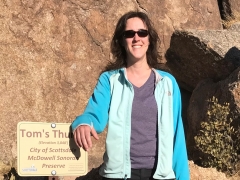
Kristen Paris
Kristen Paris is the Mastcam-Z downlink lead and has been working on the Mastcam-Z team since November 2015. Paris earned a bachelor’s degree in biology and geology from the University at Buffalo and a master’s degree in geological sciences with an emphasis in planetary geology from ASU.
Prior to joining the Mastcam-Z team, she worked at the Lunar Reconnaissance Orbiter Camera Science Operations Center at ASU for Professor Mark Robinson, where she was responsible for downlink operations.
When asked about her favorite moment so far on the mission, Paris says it was watching the launch.
“There is so much that has to go right and so much can go wrong that I'm just always impressed by a successful launch. I'm pretty sure I've teared up at every launch I've been to; they're a beautiful thing,” she said.
When asked what advice she would give to undergrads who might want to have a job like hers someday, she says that students should do what they enjoy and not be afraid to ask for things.
“I've gotten to do so many cool things like internships and a stint at the Mars Desert Research Station simply because I asked,” she said. She also recommends talking to professors and advisers about what you're interested in because they are amazing resources.
Her advice to young girls interested in STEM fields is to not let anyone tell you that it's weird that you're interested in it or that it's just for boys.
“Those people are just wrong in their thinking,” Paris said. “You always find your people whenever you do what you truly enjoy doing, so just because you might be the only person you know who is into STEM now, that will not always be the case. There are so many great resources out there, so don't be afraid to reach out!”
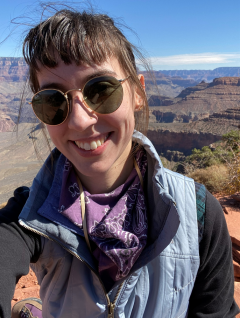
Alyssa Bailey
Alyssa Bailey has been on the Mastcam-Z team since May 2020 and is a data archivist and a payload downlink lead. She earned her bachelor’s degree in geological sciences from ASU. As the data archivist, she is in charge of preparing the cameras’ calibrated images for the Planetary Data System, which is what NASA uses to archive data collected by solar system missions. Bailey works with her Planetary Data System colleagues to create the archive and prepare image products, documents and other files for the archive.
On any given day, she might do development work like writing scripts, manually write out image labels or write supplementary documentation. As a payload downlink lead, Bailey assesses the health and safety of Mastcam-Z and reviews images once they reach Earth. In this capacity, she has to work quickly and make informed decisions while providing go/no-go status for Mastcam-Z.
“I love being part of the reason people of all ages all over the world can see our images,” Bailey said. “Most of all, I love getting to see beautiful Martian images every day.”
One of her favorite moments so far on the Mastcam-Z team was sharing her birthday with the first flight of the Mars helicopter, Ingenuity, which was documented first by Mastcam-Z.
“It was exciting to make the first gif of Ingenuity flying on Mars from the little thumbnail images we downlinked, and I got to be with my team celebrating such a historical day,” she said.
To young girls looking into STEM fields, Bailey says you have to know you are capable of doing anything if you believe in yourself.
“At a young age, I knew I wanted to pursue a STEM degree, and I would read books and seek knowledge wherever possible," she said. "I have worked a lot of jobs before working for a planetary mission, and they all taught me important life skills like working on a team. There are a lot of steps between loving space and getting a job related to it, but each step provides an important lesson to be valued and used when you reach the top.”

Kelsie Crawford
Kelsie Crawford has been a member of the Mastcam-Z team since 2019 and serves as a Mastcam-Z payload downlink lead. She earned bachelor’s degrees from ASU in physics and astrophysics.
She started as a student worker for Bell as a freshman at ASU. Three and a half years later, Mastcam-Z was hiring more downlink staff, and with her experience of the software already being used for processing Mars images, she was a natural fit for the team.
Her advice for undergrads who might want to have a job like hers someday is to sit at the front of the classroom, go to office hours and find others in your classes that you can work with.
“Your professors will notice you and the effort you make as a result, and then you are more likely to make connections with them that will help for recommendations and future research opportunities,” she said.
She also suggests searching for student worker positions in the field and asking professors if they know someone hiring students.
“Get your foot in the door during your undergrad,” she said. “People care more about your eagerness to work and learn than they do about existing skills since they can often teach you what you need to know. Then be committed, continually show up and put in hours, and actually do the work.”
Her advice for young girls interested in STEM fields is to ignore what boys may say against you.
“STEM is not easy for anyone, so do not be discouraged if you struggle at times. Seek help from your teachers and do not be ashamed to ask questions,” she said.
After Mastcam-Z, Crawford is considering several different paths.
“I had originally thought that after four years of working for Mastcam-Z that I would go to grad school for astrophysics, but I absolutely love working operations. I may look into transferring over to Psyche operations, or possibly looking into operations for a telescope so that I’m more involved with the astronomy that I love.”

Laura Mehall
Laura Mehall is a payload downlink lead and has been working on the Mastcam-Z team since 2018. Previously, she worked with Bell on the Spirit and Opportunity rover teams. Mehall earned a bachelor’s degree in astrophysics from Michigan State University and a master’s degree in geological sciences with an emphasis in planetary geology from ASU.
As a payload downlink lead, Mehall is responsible for assessing the health of the cameras by monitoring telemetry (temperatures, power and instrument states). She is also responsible for making sure all of the images that were commanded get downlinked from the rover. She then reviews the images and checks for focus, saturation and pointing. From there, she creates mosaics and color anaglyphs of the images, as well as videos for the science team.
Working on Mastcam-Z was Mehall’s second experience living on Mars time. When she worked on the Mars exploration rovers Spirit and Opportunity, her husband was also working on Mars time, and they were located at NASA's Jet Propulsion Laboratory.
“On this mission, my husband is not on Mars time, and I have two kids and a dog,” she said. “So it’s much more difficult, and sometimes I didn't see my family for two days or more while we were living in the same house.”
Mehall’s favorite moment of the mission to date was the first helicopter flight for Ingenuity. Since the Mastcam-Z cameras were taking videos of this historic moment, Mehall was one of the first people to watch an inaugural powered-controlled flight on another planet.
“It was like getting a front row seat at the Wright brother's first flight ... absolutely thrilling!”
Her advice for undergrads who might want to have a job like hers someday is to work hard, ask a lot of questions and reach out to the groups that you would like to work with and see if they are hiring.
“It's a great way to get your foot in the door,” she said.
Her advice for young girls interested in STEM fields: “Don't listen to anyone that says science and math are too difficult. If you have a goal and you are willing to work hard, you can achieve anything.”
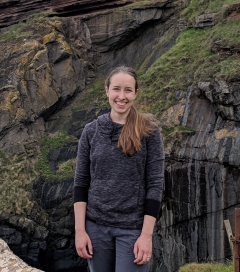
Kathryn Powell
Kathryn Powell is the newest member of the Mastcam-Z team, having joined in July 2021. As a payload downlink lead, she is responsible for ensuring that the instrument is functioning correctly and ready to do more science on Mars. She also verifies that all the images that they ask the cameras to capture make it back from Mars to the computers on Earth. She then stitches these images together into larger mosaics and panoramas to help scientists and engineers do their jobs.
Powell earned a bachelor’s degree in astrophysics from Rice University and a master’s degree and PhD in earth and planetary sciences from Washington University in St. Louis.
Her advice for undergrads who might want to have a job like hers someday is to get involved as soon as possible.
“If you're at a big planetary science institution like ASU, you can look for job opportunities either during the summer or the school year,” she said. “If not, get whatever research experience you can during the school year and apply for summer research internships at other institutions.”
For young girls interested in STEM fields, Powell says, “Don't be intimidated! It's OK to struggle sometimes — everybody does, even if they don't always show it. Ask for help when you need it and keep trying.”
Powell hopes to stay involved in planetary mission work throughout her career.
“Every opportunity I've had in my career has taught me new skills and provided me with valuable experiences, and I plan to apply those lessons learned going forward,” she said.
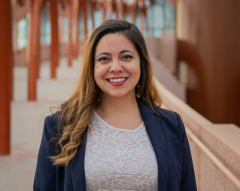
Corrine Rojas
Corrine Rojas has been working on the Mastcam-Z team as a payload downlink lead since April 2019 after completing an internship at NASA’s Jet Propulsion Laboratory, where she worked on Curiosity rover operations.
As a payload downlink lead, Rojas makes sure that the Mastcam-Z cameras are functioning well and that the pictures they take are exactly what was planned. In this role, she is one of the first people to look at pictures from Mars taken by the Perseverance rover. She then stitches together these images to create panoramic mosaics for the team and the public.
Her advice for young girls interested in STEM fields is to take time to find out what they are passionate about and know that it’s OK to not be great at it at first.
“My road to working for NASA missions was paved with a lot of failure, but it didn't stop me from doing my best on the next try,” she said.

Samantha Jacob
Samantha Jacob joined the Mastcam-Z team shortly after she started her PhD in the spring of 2018. She had previously been involved with the operations and science teams for the Mars Curiosity rover and that rover’s Mastcam instrument, also led by Bell.
Jacob is currently a fourth-year PhD candidate, and she earned her bachelor’s and master’s degrees in geology and geophysics from the University of Hawaii at Manoa.
Jacob has several different roles on the team, including tactical documentarian, science payload downlink lead (verifying the new data when it arrives on Earth), and science payload uplink lead, where she helps plan the science activities that the rover will be doing the next few days on Mars.
Her favorite part of working on the Mastcam-Z team is being one of the first few people to see an image from Mars.
“To wake up and start the day looking at rocks on a different planet is incredible,” she said.
The advice she would give to undergrads who might want to work on a project like Mastcam-Z someday is ask to get involved.
“Sometimes the answer might be no, but by not asking, the answer will always be no,” she said. “At least if you ask, the answer could be yes, and years later, it could change your life and career.”
For young girls interested in STEM fields, she suggests that they shouldn’t be afraid to show up, be confident, take a break when they need it, and start from the beginning when one path leads to a dead end.
“Dead ends feel like failures sometimes, but they are just lessons in disguise,” she said.
Her plans for the future are to continue in a career that allows her to do research and rover operations, until she becomes an astronaut and can actually go to the moon or Mars.
“Sometimes being a geologist who mostly sits in front of a computer, I feel like I’m missing out, but then I remember I’ve selected a Mars rock to analyze, I’ve gathered the data and I’ve interpreted the results," she said. "I just happen to be a few hundred million miles away.”

Mohini Jodhpurkar
Mohini Jodhpurkar is a geological sciences PhD student at ASU and has been working on the Mastcam-Z team since July 2020. Bell is her adviser, and she works in mission operations as a member of the science team. She earned her bachelor’s degree in geology from the College of William and Mary in Williamsburg, Virginia.
Jodhpurkar assists with several areas of the mission, including as a documentarian on the project side and attending meetings where decisions are being made about what instrument activities can fit in the plan and what needs to get cut because there isn’t enough time, power or data volume. She also takes shifts on the instrument level with Mastcam-Z, helping to plan activities for the cameras and working with the data as it comes down to Earth.
Her favorite part of working on the Mastcam-Z team is being one of the first people to see what the Perseverance rover is investigating.
“I get to look at these images from the Martian surface and apply the lens of my own geologic knowledge to point out patterns in what we're seeing or features that stand out,” she said. “And maybe even start to form some sort of interpretation of own, only to have that grow and be refined by input from the brilliant minds on the science team.”
“It's really cool, and at the same time, humbling to be a part of something so much bigger than myself and to constantly be learning through the process,” she said.
Her advice to anyone interested in pursuing a job in space exploration is to not let society dictate your path.
“There may be people along the way who tell you, ‘You don't belong’ — but don't let that bog you down," she said. "Step on it to get to higher ground instead, and don't stop pursuing what you want.”
She also recommends being grateful and acknowledging those who help you along the way.
About Mastcam-Z
Mastcam-Z is a dual camera system that can zoom in (hence the "Z" in "Mastcam-Z"), focus and create 3D pictures and panoramas at a variety of scales. This will allow the Mars 2020 rover to provide a detailed examination of both close and distant objects on Mars.
The two cameras are mounted on the Mars 2020 rover mast at the eye level of a six-and-a-half-foot tall person. They are separated by 9.5 inches to provide stereo vision, and they will produce images of color quality similar to that of a consumer digital HD camera (2 megapixels).
Images from Mastcam-Z are available on the NASA and JPL Mars 2020 websites and on the Mastcam-Z Mars Images webpage.
The cameras are designed to help other Mars 2020 experiments on the rover by looking at the whole landscape and identifying rocks and soil (regolith) that deserve a closer look by other instruments. They will also spot important samples for the rover to core and cache on the surface of Mars, for eventual return (by a future mission) to Earth.
Bell leads the Mastcam-Z team, which includes dozens of scientists, engineers, operations specialists, managers and students at ASU and other universities, companies and government labs around the world. The team includes deputy principal investigator Justin Maki of NASA's Jet Propulsion Laboratory; the Planetary Society, which serves as the instrument’s education and public outreach partner; and Malin Space Science Systems, Inc., which is the prime subcontractor for instrument development and uplink operations.
About the Mars 2020 Mission
Mars 2020 launched from Cape Canaveral Air Force Station in Florida in July 2020 and arrived at Mars on Feb. 18, 2021. The mission is expected to last at least one Mars year (687 Earth days). NASA’s Jet Propulsion Laboratory will manage operations of the Mars 2020 rover for the NASA Science Mission Directorate at the agency's headquarters in Washington, D.C.
The mission is part of NASA's Mars Exploration Program, a long-term effort of robotic exploration of the red planet. The mission addresses high-priority science goals for Mars exploration, including key questions about the potential for life on Mars. The mission also seeks to gather knowledge and to demonstrate technologies that address the challenges of future human expeditions to Mars. These include testing a method for producing oxygen from the Martian atmosphere, identifying other resources (such as subsurface water), improving landing techniques and characterizing weather, dust and other potential environmental conditions that could affect future astronauts living and working on Mars.
Top photo: Members of the Mastcam-Z team in Mars Mission Operations in ISTB4 on the ASU Tempe campus.
More Science and technology

Applying AI to microelectronics manufacturing
Rivers flow across the planet’s surface, carving deep valleys and intricate canyons. Likewise, makers of microelectronics direct plasma, an ionized gas, to travel over silicon wafers, etching…

Applied Materials invests in ASU to advance technology for a brighter future
For nearly 60 years, global giant Applied Materials has been hard at work engineering technology that continues to change how microchips are made.Their products power everything from flat-panel…

Meet ASU engineering students who are improving health care, computing and more
Furthering knowledge of water resource management, increasing the efficiency of manufacturing point-of-care health diagnostic tools and exploring new uses for emerging computer memory are just some…


